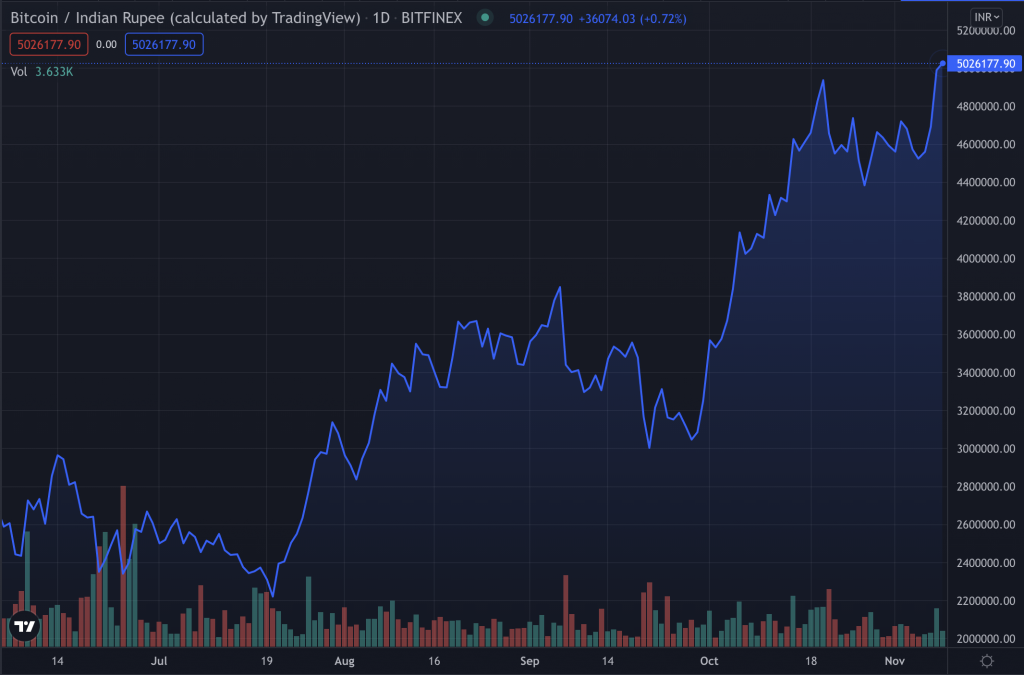Introduction
On October 31, 2008, while the world was reeling from the aftermath of the Great Recession – an idea was unleashed. Sent out in a mailing list for cryptography enthusiasts under the anonymous name of Satoshi Nakamoto – across 8 pages, the idea of Bitcoin was outlined – an electronic payment system that operated on cryptographic proof where no intermediaries like banks or governments were needed. Read Satoshi’s original whitepaper here.
64 days later, on the 3rd of January 2009, the bitcoin network came into existence with Satoshi mining the genesis block of bitcoin (block number 0), which had a reward of 50 bitcoin. Embedded in the coinbase parameter of this block was the text: “The Times Jan/03/2009 Chancellor on brink of second bailout for banks”. The message referred to a headline of a news article that appeared that day in The Times in the UK that talked about a second bailout for the banks to help them survive the financial crisis.
And fast forward to today, when Bitcoin and cryptocurrency in general has been garnering a lot of attention and media coverage – very often this has been about the price and the volatility – but increasingly, it is being apparent that Bitcoin can become a better alternative to traditional financial systems just like it’s founder(s) envisioned.
At the time of publishing, the price of 1 Bitcoin is hovering just over Rs 50 lakh, and it is expected that the market price for Bitcoin is expected to rise due to having a fixed supply of only 21 million coins and the increasing demand in recent years from individual investors, companies as well as institutions.
So, let’s dive into what it is to understand what all the rage is about and why you should care.
What is Bitcoin?
Bitcoin is a digital payment system – a decentralized digital currency that uses peer-to-peer technology to operate without the need for any central authority or banks. The issuing of bitcoin, management and verification of the transactions are carried out collectively by the network.
This means anybody can use Bitcoin the way they want – to send and receive value, while creating “wealth without borders”.
Compare this with traditional financial systems – which are permissioned which means banks and the government set out the rules, telling people what they can do with their money and setting out restrictions. On the blockchain network, no government or any other central authority can censor permissionless transactions and Bitcoin payments are tamper-proof.
With it’s increasing recent popularity, Bitcoin is a testament to how anybody can participate in public blockchains and not get discriminated against based on country, race, religion, age or national rules/regulations.
In simple terms, it is virtual currency made for the people, by the people, and is of the people. But Bitcoin’s benefits aren’t virtual, they’re very much real. And we will be exploring that later on.

Bitcoin Vs Fiat
Fiat currencies are government-backed currencies like the Indian Rupee or the United States Dollar – these aren’t linked to any commodity like gold but are rather regulated by central banks/authorities.
To put it simply, fiat currencies run on trust in the central authority issuing the currency – since fiat has value only because the government declares it as key tender
Let’s understand the key distinctions between Bitcoin and fiat currency – that will help you understand what makes Bitcoin different and why it is the better alternative.
- Divisibility
One Indian Rupee is divided into 100 paise but Bitcoin is divisible to greater fractions – 8 decimal points to be precise. The smallest unit of Bitcoin are called Satoshis (commonly referred to as sats) which is named after the creator of Bitcoin, and sats are used to refer to Bitcoin in its fractional states.
1 Satoshi is equal to 0.00000001 Bitcoin and 10crore sats make 1 Bitcoin.
The tiny fractions creates the possibility to perform micro digital transactions while also helping drive up the adoption of Bitcoin.
- Durability
Bitcoin is not prone to physical deterioration or damage like Fiat currencies.
The process of transferring money is completely digital and Bitcoin is tremendously valuable since it cannot be destroyed physically like printed fiat currencies.
Bitcoin blocks will continue to exist on the Bitcoin blockchain and records cannot be altered as they are immutable.
- Usability
One of the biggest benefits of Bitcoin over Fiat is that it is decentralized and not governed by central banks and authorities.
But it doesn’t stop there, and in the Bitcoin market, trust has to be established among all users in order for the system to work as intended. There is a sophisticated series of transaction validation and verification checks, making Bitcoin transactions immune to fraud, laundering, or theft.
Real life assets can be tokenized on Bitcoin and traded worldwide with other parties, organizations, and users. Lastly, payment details such as Bitcoin addresses are transparent and on the public blockchain for all to see.
- Anonymity
If a bank or company wants to make a huge payment internationally, the currency is at risk of getting lost during shipment or transit. Fiat currencies have to go through international laws, regulations, and many legal procedures before they’re converted into another currency and approved for transactions. The identity of users gets compromised and it is not possible to make anonymous transactions.
Bitcoin payments are different. They require no conversions and since there are no central authorities or legal intermediaries involved, transactions are almost instant. If someone wants to send money from Africa to India in BTC, he/she doesn’t have to worry about currency conversion rates, international processing fees, etc.
All one has to do is simply acquire the BTC wallet deposit address and transfer BTC there. Withdrawals are fairly simple and it takes minutes to process. Bitcoin transactions do not require ID verification and all transactions are stored permanently on the Bitcoin blockchain. The identity of users is never revealed when they’re making trades and purchases.
- Inflation or Mehngayi (rising costs)
The fact that fiat currencies have centralised control creates a huge risk. This means that they significantly lose their value to inflation when a country prints excess currency if suffering from bankruptcy or facing an economic crisis like hyperinflation – that could even be caused by countries printing more money into the system during times of recession.
In other words, 1 bitcoin = 1 bitcoin. ALWAYS.
Since Bitcoin is not controlled by the RBI or any central authorities, it is not susceptible to inflationary policy decisions and will remain a better hedge against inflation and other uncertainties and problems in the global and national economy.
Benefits of Transacting in Bitcoin
Bitcoin transactions charge lower processing fees for international payments and can be made by unbanked users. Here’s a list of benefits users enjoy when transacting with Bitcoin online.
No Blocked Payments – You don’t have to worry about transaction delays or blocked payments. Making a payment to a BTC address is almost instantaneous and just takes just 10 minutes.
Limited Supply – Paper money is printed by the Government and Central banks in unlimited amounts. This affects the price of Rupee and unlike Fiat currencies, Bitcoin cannot be counterfeited.
The maximum supply of Bitcoin is capped at 21 million and its value per coin is expected to increase over the years due to fixed supply and increasing demand.
No Server Shutdowns – Banks can suffer from server shutdowns and can be prone to operational failures. Bitcoin is mined in blocks on the base layer. Although larger amounts can take more time to process on the blockchain network, Bitcoin transactions made through the Lightning network are instant just like Indian UPI.
No banking fees are incurred on Bitcoin payments and Bitcoin transactions can be made by those who do not have a bank account as well. All they need is a smartphone and an internet connection. Settlements are immediate and the technology offers protection from payment fraud.
No Economic Crisis – Bitcoin is not prone to economic crises in history such as demonetization, national bankruptcy, etc.
Since it is completely decentralized and designed for the people, by the people – it stays immutable.
No Chargebacks – Bitcoin transactions are not susceptible to cases like chargebacks, canceled cheques, or failed transactions. They are pseudo-anonymous, offer user autonomy, and a majority of Bitcon transactions are done via mobile apps.
Bitcoin Taxation in India
The Income Tax Authority of India has not made it clear whether Bitcoin is to be treated as a foreign asset. However, all assets or trades made within or outside India are taxable according to Income Tax Act of India guidelines. Here’s a brief overview of how it works.
- There are no specific provisions for Bitcoin taxation in the Income Tax Act of India but as per General Account rules, crypto asset owners have to file tax returns every year just like for their other assets
- You can buy Bitcoin as an investor or trader. Income is taxed as per Capital Gains for profits and the holding duration can range from 1 month, 6 months, and up to 1 year for investors. Traders can buy, sell, or trade Bitcoin by the hour, day, or minute. Short term capital gains are profits made within a time period of less than 36 months. Any profits made from investments held longer than 36 months are classified as long-term capital gains
- Net profits and losses have to be booked and recorded in your accounting by the end of every financial year. Traders file their income from crypto assets under ‘Income from other business sources’
- For investors, the taxation rate is 20% for assets held longer than 8 years. Additionally, you are eligible to apply for a Cost inflation Tax (CIT) to reduce your tax liability. Day traders have to file taxes under ‘Income from Business and Profession.’
- Income tax is direct tax and GST is indirect tax. If you receive Bitcoin from an international merchant or account, GST is not applicable on your services.
- However, if you’re providing services in India, up to 18% GST is applicable on sale of goods and services. To get exemption from GST and reduce your tax liability for foreign transactions, it is a good practice to receive crypto payments as a foreign convertible currency and furnish a Foreign Inward Remittance Certificate.
How to file tax returns for earnings made on Bitcoin payments?
If you are a Bitcoin investor, simply file your earnings as Capital Gains and use ITR Form-2
For day trading and mining, use ITR Form-3.
If you are receiving your salary in Bitcoin, it’s important to ask your employer to convert your service agreement into a contractual basis. There are no TDS compliance provisions for contractors, consulting services, and service providers in crypto.
The best apps available in the market for calculating Bitcoin tax liability in the Indian market are Koinly and Beartax.
How to Get Started with Bitcoin
The easiest way to get started with Bitcoin is by investing in Bitcoin and own your first sats.
You could do this by opening a trading account with any of the Indian exchanges. Some of the prominent ones are Unocoin, CoinSwitch Kuber, CoinDCX and WazirX. The benefit of using Indian crypto exchanges for buying Bitcoin versus opening accounts in international exchanges is that you get accurate market conversions for USD to INR payments.
As you learn more about Bitcoin, you could even consider mining coins using phones, laptops or other specialized devices.
The GoSats app is another terrific way to get into investing in Bitcoin for the first time and continue passively investing in Bitcoin every time you shop.
You simply shop online using your credit/debit card on various platforms and earn cashback in the form of satoshis. GoSats lets you stack sats in your BTC wallet and withdraw whenever you reach the minimum withdrawal limit.
If you’re planning to use an international Bitcoin wallet address for your crypto payments, you can do that too.
To learn more about the world of Bitcoin and why you should start using GoSats. Follow our blog and be sure to check out our upcoming posts.


